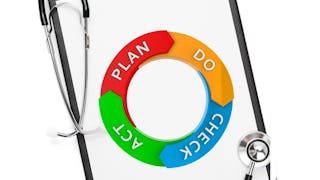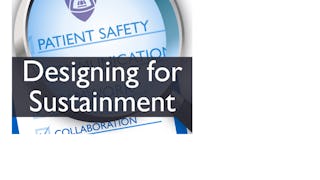This course provides a comprehensive overview of how healthcare organizations function, adapt, and maintain quality and safety in patient care. Learners explore healthcare systems, delivery models, and reimbursement structures. The course covers patient safety standards, resource allocation, and regulatory compliance, emphasizing the nurse’s role in improving efficiency and quality. Students also examine quality improvement processes, professional development, and emergency preparedness in healthcare settings. By the end of this course, learners will understand how healthcare organizations operate, how policies and systems influence patient outcomes, and how nurses contribute to quality, safety, and cost-effective care.

New! Discover how 91% of learners achieved at least one positive career outcome. Learn more.


Recommended experience
What you'll learn
Explain how healthcare systems and delivery models impact patient care.
Identify key regulations, safety standards, and reimbursement systems.
Learn quality improvement principles to enhance healthcare outcomes.
Recognize the nurse’s role in organizational effectiveness and patient safety.
Skills you'll gain
Details to know

Add to your LinkedIn profile
October 2025
9 assignments
See how employees at top companies are mastering in-demand skills

There are 3 modules in this course
This module introduces students to the structure, organization, and operational principles of modern healthcare systems. Students will explore issues of access to healthcare and the factors that influence care availability across diverse populations, understanding Diagnosis-Related Groups (DRGs) and their impact on reimbursement and care delivery. The module emphasizes the various levels of care from primary to tertiary settings, principles of resource allocation and utilization that affect healthcare efficiency, and different nursing care delivery systems used to organize patient care. Students will also examine emergency management and preparedness protocols essential for responding to disasters and public health emergencies. Through this exploration, learners will develop a comprehensive understanding of how healthcare systems function, the challenges facing modern healthcare delivery, and the nurse's role in navigating and contributing to effective healthcare organizations.
What's included
6 videos6 readings3 assignments
This module examines the regulatory frameworks and safety principles that ensure quality healthcare delivery and protect patients from harm. Students will explore healthcare regulation and accreditation processes, the role of professional organizations in setting practice standards, and various types of reimbursement systems that influence care delivery. The module emphasizes key principles of patient safety, including standard precautions for infection control, National Patient Safety Goals (NPSG) established by The Joint Commission, and safety considerations across the lifespan from pediatric to geriatric populations. Students will also examine how to foster an organizational culture of safety that encourages error reporting, continuous improvement, and accountability. Through this exploration, learners will develop the knowledge and skills necessary to practice safely within regulatory requirements, contribute to quality improvement initiatives, and advocate for patient safety in healthcare organizations.
What's included
8 videos8 readings3 assignments
This module explores the principles and practices of quality improvement in healthcare settings and the tools used to measure and enhance patient outcomes. Students will examine effective teaching and learning strategies for patient education and professional development, as well as the role of technology and informatics in supporting quality care delivery and data-driven decision-making. The module emphasizes healthcare quality improvement methodologies, including systematic approaches to identifying and addressing gaps in care. Students will learn to interpret healthcare quality measures and quality indicators used to assess organizational performance, patient outcomes, and adherence to evidence-based standards. Through this exploration, learners will develop the competencies necessary to participate in quality improvement initiatives, utilize technology effectively, and contribute to the delivery of high-quality, safe, and efficient patient care.
What's included
5 videos5 readings3 assignments
Instructor

Offered by
Explore more from Healthcare Management
 Status: Preview
Status: PreviewThe George Washington University
 Status: Free Trial
Status: Free TrialRutgers the State University of New Jersey
 Status: Free Trial
Status: Free TrialJohns Hopkins University
 Status: Free Trial
Status: Free TrialUniversity of Michigan
Why people choose Coursera for their career





Open new doors with Coursera Plus
Unlimited access to 10,000+ world-class courses, hands-on projects, and job-ready certificate programs - all included in your subscription
Advance your career with an online degree
Earn a degree from world-class universities - 100% online
Join over 3,400 global companies that choose Coursera for Business
Upskill your employees to excel in the digital economy
Frequently asked questions
To access the course materials, assignments and to earn a Certificate, you will need to purchase the Certificate experience when you enroll in a course. You can try a Free Trial instead, or apply for Financial Aid. The course may offer 'Full Course, No Certificate' instead. This option lets you see all course materials, submit required assessments, and get a final grade. This also means that you will not be able to purchase a Certificate experience.
When you enroll in the course, you get access to all of the courses in the Specialization, and you earn a certificate when you complete the work. Your electronic Certificate will be added to your Accomplishments page - from there, you can print your Certificate or add it to your LinkedIn profile.
Yes. In select learning programs, you can apply for financial aid or a scholarship if you can’t afford the enrollment fee. If fin aid or scholarship is available for your learning program selection, you’ll find a link to apply on the description page.
More questions
Financial aid available,


